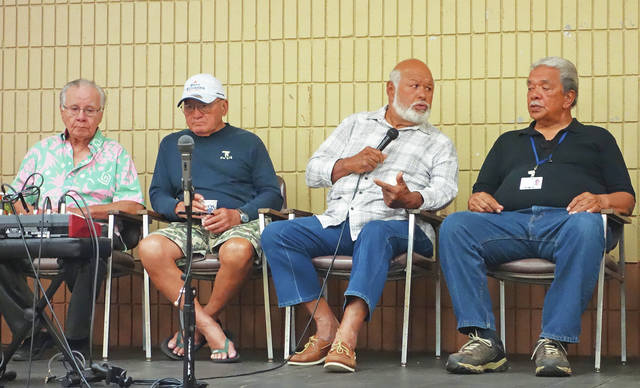WAIMEA — Alex Akau remembers when his family first moved into Waimea Home Lands.
“I was nine years old,” he said at the Waimea Hawaiian Homesteaders’ Association monthly meeting May 10. “We had nothing but gravel roads and it was always said we would have a park there. But nothing ever happened.”
Thanks to the association’s current president, Mike Hodson, something is happening now, some 66 years later.
Planning for Waimea Nui Park began in 1952. An initial conceptual plan was created in 1964 and another was drawn up in the 1970s. Then in the ‘90s, an engineer at Hawaiian Home Lands came up with another plan but nothing came to fruition.
In 2011, some 30 years later, Hodson created the current Waimea Nui Park plan and things have been moving forward ever since. In 2014, $3.5 million was allocated by then-Gov. Neil Abercrombie to fund the project. In November 2015, Waimea Hawaiian Homesteaders’ Association received approval for a 65-year general lease for the land.
Groundbreaking for the 161-acre project was celebrated in December 2016. The plan now includes community agriculture and equestrian parks, a cemetery, a recreation and fitness community complex and a rural health center.
The first phase will focus on the infrastructure, building a road and bringing water into the park.
“Only one-third of the road is finished currently. Hopefully, as the governor releases the $800,000 soon, we’ll probably get started in mid-August,” Hodson said. “We’ll stretch that money as far as we can to get that infrastructure done, including safe drinking water on the whole property — especially to the ag park.”
Two 100,000-gallon water tanks will be located on the east side of the park.
“The purpose is to set up flotation devices on the tanks that will only be filled at night so it won’t affect Lalamilo’s water system,” Hodson said.
Despite progress the last few years, working with the state government has sometimes been laborious.
“Getting the funds to make this happen with all the different agencies and offices is difficult,” Hodson said. “But the State Department of Agriculture’s Chairman Scott Enright is still one of our biggest partners. He wants to see the park come up as a state ag park model for food security.”
At the May 11 meeting, Rep. Cindy Evans voiced her continued support.
“The legislature will do whatever our part is through grant aids. We just need to keep rolling it out and getting it spent so you can keep the process going,” she said.
Private foundations have also expressed interest in supporting the project, once the infrastructure is completed.
On June 12, Waimea Nui Park may be a topic of conversation at the Biodiversity Funders Group annual meeting in Kona. Hodson, who also operates WOW Farms with his wife, Tricia, will both attend the meeting. The group “organizes programs to target attention on selected topics and to explore the process of strategic, collaborative grantmaking,” according to their website.

